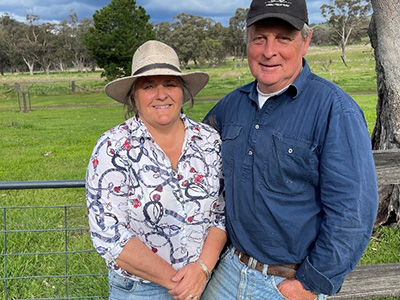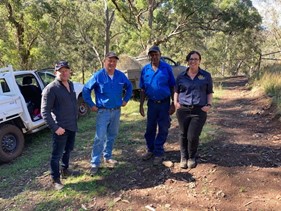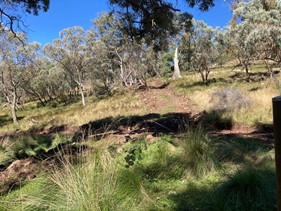Case study: Reaching out to the Regent Honeyeater
Introduction
Will and Jillie Arnott were very interested in protecting good quality remnant habitat on their sheep and cattle property “Coolah Creek” adjacent to Coolah Tops National Park in NSW. As a priority area for the critically endangered Regent Honeyeater, the Arnott’s had an underutilised large remnant area containing critical habitat for the Regent Honeyeater that they were keen to protect.
After reading about the plight of the Regent Honeyeater and through discussions with their local Landcare coordinator and Central West Local Land Services, the Arnotts’ put in an Expression of Interest and received a site visit from Local Land Services to assess the importance of the project area. They were successful in receiving funding to protect this habitat which would enhance the bird’s natural habitat on the property. Working with Central West Local Land Services they planned the project area, which entailed fencing out 123 hectares from grazing livestock and installed alternate water points outside this area.

Jillie and Will Arnott.
This work would protect the Regent Honeyeater’s habitat from ground cover damage by livestock and feral animals and would improve biodiversity for many other native plants and animals.
A long term vision
With this funding and technical assistance from Local Land Services, Jillie and Will have been able to protect this large area by upgrading infrastructure and installing off-creek watering points. The natural spring that provided water for stock in the conservation area was regularly trampled and damaged by stock and feral animals, but now will be able to recover and provide better habitat for frogs and other aquatic life important to this creek line.
The Arnott’s are proud to say they have been able to protect and enhance the stunning natural habitat in an area that is unproductive as a farming enterprise but is and will be a “naturally rich” part of their property. They have created long term environmental sustainability for this project area.
“The long term vision is to maintain what we are doing at the moment, but balance that with environmental issues. We are very conscious of making sure that certainly during dry periods we’re not overstocking the place. We want to look after the environment and the native flora and fauna that are on the property. So, it is about maintaining the balance,” said Will.

Figure 2. Conducting a Cultural Heritage survey at “Coolah Creek”.
The challenge
Will and Jillie had several conversations with Central West Local Land Services about how to best protect the Regent Honeyeater habitat on their property.
The 123ha area consists of steep gorge country with the Coolaburragundy river running through it and was going to be difficult to access and fence. As it provides home to important local native flora and fauna and in the future habitat, food sources and breeding habitat for the Regent Honeyeater they needed to get the planning right.
The Regent Honeyeater and the biodiversity of this area are under threat from invasive species such as feral goats, pigs and wild deer - all cause damage to the sensitive ground cover, eat naturally regenerating species and cause erosion. On-going control of the highly invasive species St. John’s Wort is a priority for the Arnotts.
All of this had to be factored into the project along with wetter than normal conditions and flooding occurring on several occasions on the Coolaburragundy River.
“The Regent Honeyeater Project came about through a discussion that my wife Jillie had with the local Landcare coordinator in Coolah and that progressed to various discussions with our Local Land Services Officer. There were several information brochures issued which we studied and having read up on the information that was provided, I thought, well, this is a very worthwhile project to get involved in considering it is a critically endangered species. With a specific area in mind and not utilised on “Coolah Creek” we wanted to do what we could in terms of enhancing that area for a worthwhile cause, such as the Regent Honeyeater, we thought that was a particularly good thing to do!” said WIll.
The more the Arnott’s learnt about the unique biodiversity on their property, the more they were inspired to take on the project and to make a long-term and lasting impact on the future of the ecology of this beautiful natural ecosystem on their property. Local Land Services assisted them with regular contact and help to complete this important project.

Figure 3. White box country on Coolah Creek.
Work undertaken
The project area, fence line location was decided and mapped, (including fence type and lengths) along with alternate watering point locations, water pipe and tanks for the off river watering points. Very wet weather delayed project work for some months both for clearing of the lines to be fenced, the 4.8km of fencing and installation of 2 new water points, piping, trough and tanks. Weed control and pest animal control will be carried out over the next 10 years as part of the project.
“As the country was so steep there was a lot of planning and preparation for earthworks to begin clearing areas of the new fence line. Fencing was either brand new and some areas were repaired or modified to fit the requirements of the fence in this type of country. The area that we've fenced out is about 123 hectares of which there is probably another 200 hectares on the other side of the river. So it's probably the start of something that could be potentially much bigger… having fenced out this area, we've had to put in a new watering system to accommodate the grazing paddocks. There are two alternate troughs and tanks and about three kilometres of water pipe that we've put in as an essential part of the entire project,” Will said.
Result, benefits and learnings
Jillie and Will said before they had learnt more about the Regent Honeyeater and the unique ecology on their property they probably wouldn’t have done these works without the funding. However, they now say they are invested in the project and that this could just be the start of an even larger long-term future for the project. They have made a commitment to creating better natural systems on “Coolah Creek”.
“I suppose the most unexpected outcome is the fact that on Coolah Creek there could be Regent Honeyeaters in the first place. It has been seen here, but I was unaware of it and I was certainly unaware of the fact that it was a critically endangered species. So for me, I suppose a good outcome, albeit unexpected, is that we're now focused on it and we're putting in the infrastructure to make sure that it is going to survive. I think it's really a win-win in the sense that we're utilising what was essentially under-utilised land for a worthwhile project that's going to hopefully ensure the survival of an endangered species. Sometimes you are a bit sceptical when you start out with these things, but I think having gone into it and seeing the benefits and the focus that we've put into it and the outcomes that we have achieved to date, orbit's fairly early on in the project, I'd certainly recommend doing that sort of thing,” Will said.
Hear from Jillie and Will Arnott
Funded by
This project is supported by Local Land Services, through funding from the Australian Government’s National Landcare Program.
For more information
Contact your nearest Local Land Services office on 1300 795 299.